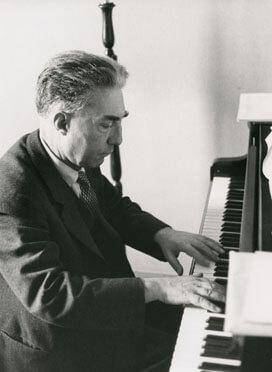Commissions & Premières
Luigi Dallapiccola, whose parents were from Trent, was born in 1905 in Pisino d’Istria, at the time a small town in the Austro-Hungarian Empire. In this part of the world, defined by the composer himself as “a crossroads between three frontiers”, he spent his entire childhood and adolescence except for the months in which his family, on account of World War I, was evacuated to Stiria. After returning to Pisino at the end of the war, Dallapiccola continued his studies in music first in Trieste and then at the Cherubini Conservatory in Florence, where he took a diploma in piano in 1924 and another in composition in 1932. While studying in Florence, he deepened his knowledge of composers like Ravel, Debussy, Bartok, Stravinsky and Hindemith. A performance of Pierrot lunaire that Schoenberg himself conducted in Palazzo Pitti in 1924 left a deep impression on the young musician. Indeed, he came to consider the Viennese maestro’s ‘Theory of Harmony’ a fundamental reference text. Florence became Dallapiccola’s adopted city and he lived there for the rest of his life. He taught piano at the conservatory for over thirty years, with the exception of a few years during World War II when he was assigned the professorship of composition. At the same time he also pursued an intense performance career playing in a duo with the violinist Sandro Materassi both in Italy and abroad.
Starting from the 1930s Dallapiccola’s compositions began to attract increasing attention from the critics. Partita for orchestra, composed in 1933, was the first to enjoy success with a wider audience. The work, divided into four movements, introduces in the finale the voice of a soprano that intones a text that comes from a Medieval collection ‘Naenia Beatae Mariae Virginis’.
The language of Dallapiccola, one of the first Italian musicians to become interested in Schoenberg’s method, marked a turning point in Italian musical culture. His adoption of dodecaphony, as observed by Roman Vlad, came about in a gradual and original manner, through the transformation of the chromatic elements of his initial diatonic-modal style into full-fledged 12-note series. Chromatic passages are present, for example, in the Divertimento in quattro esercizi for soprano and 5 instruments (1935), in which Dallapiccola, in search of a formal balance, uses pre-classical forms, while in the Coro degli zitti (for mixed voices and large orchestra, the first of the third series of the Cori di Michelangelo Buonarroti il Giovane), Bach-like contrapuntal artifices stand alongside 12-tone series of an expressive nature.
The composer’s first real exploration of the potential of the new language, however, took place in subsequent works. The Tre laudi (1937) for voice and 13 instruments presents for the first time melodic lines that make use of all twelve sounds of the chromatic scale. Material from the Tre laudi was at a later stage taken up again in the one-act Volo di notte (1940), which was drawn from Saint-Exupéry’s ‘Vol de nuit’ and marked Dallapiccola’s debut as an opera composer. In this work Dallapiccola demonstrates a great awareness of the operas of Alban Berg, especially in his use of a modern recitative style and in the way he modelled his dramaturgy on instrumental forms. The Canti di prigionia (1938-1941), for voices and instruments, represents his most important work in the years leading up to World War II. The origin of this work was the speech in which Mussolini, in September 1938, announced his campaign against the Jews, a policy that directly struck the composer’s wife. Canti di prigionia is divided into three parts, but it has a unitary character, both on account of its extensive use of a single 12-note series and for the connecting thread that unites the three songs or, to be precise, the use of fragments of the Dies irae.
Of the works composed during World War II two in particular stand out: the Piccolo concerto per Muriel Couvreux for piano and small orchestra (1941), and the dramatic ballet Marsia (1942-43), written in collaboration with the choreographer Aurel M. Milloss. Divided into three parts, which follow on from each other without interruption, Marsia alternates lyrical moments with moments marked by a relentless rhythm, while diatonic elements contrast with 12-tone elements. These works were followed by the three series of the Liriche greche, composed between 1942 and 1945, for voice and various instrumental combinations, in which, alongside the serial component, there appear tonal reminiscences and a distinctive attention to pure ‘cantabilità’.
In the years following World War II Dallapiccola’s fame began to spread both in Europe and the United States, where he held advanced courses at Tanglewood, attended by amongst others Luciano Berio, and in New York. In 1950 he wrote the one-act opera Il prigioniero, on a libretto that he himself wrote and which was based on Villiers de l’Isle-Adam’s ‘La torture par l’esperance’, and the sacred representation Job, drawn from the Book of Jacob. As the years went by Dallapiccola’s 12-tone style became more and more essential and characterised by a profound lyricism. This can be seen in his numerous vocal works, in particular in the Canti di liberazione (1955) for choir and orchestra and in his final work for the theatre, Ulisse (1968). Commiato for soprano and chamber group, written in 1972, was the composer’s last composition.
Dallapiccola died in Florence on February 1975.
Piccola Musica Notturna
for Orchestra
28 September 2024 ASIAN PREMIÈRE

